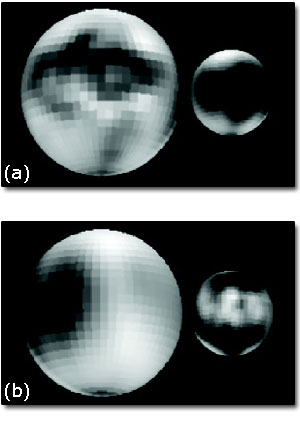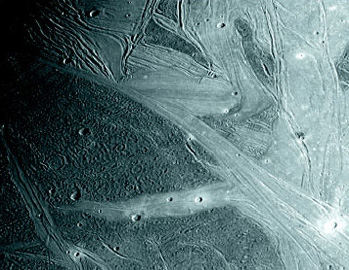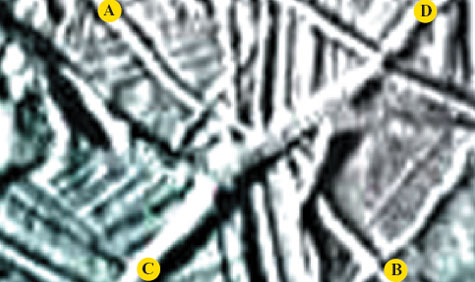3 Other icy bodies as abodes of life?
You have seen that Europa offers arguably the most promising habitat for present-day life in the Solar System, other than on the Earth itself. This is because ice or water overlying warm rock can lead to hydrothermal circulation, offering hot springs where life could originate in the first place and subsist on chemical energy thereafter. There would not actually have to be a global ocean below the ice, but this would help by allowing organisms to spread from one vent to another.
Question 25
Can you suggest places in the Solar System where conditions might now be, or might formerly have been, sufficiently similar to Europa for life to have got underway there too?
Answer
Any of the tidally heated icy satellites would seem promising, especially those that were at any time heated sufficiently for a global ocean to form below the ice. Of those illustrated earlier in this course, Callisto and Rhea (Figure 10 in Section 1.3) do not seem promising, whereas Enceladus and Ariel (Figure 11b and d in Section 1.3) would seem the likeliest.
Enceladus is particularly intriguing. Voyager obtained useful images of less than half its surface (Figure 11b). Although parts are fairly heavily cratered, other areas seem smooth even on the highest resolution (2 km per pixel) images. The Cassini mission has made several close fly-bys of Enceladus, revealing that the 'smooth' areas are actually finely fractured and, more intriguingly, a zone of warm cracks near the south pole from which jets of water-ice were seen to be sprayed into space. The power source is most likely to be tidal, and this proof of the combination of heat and water has nudged Enceladus up the rankings of potential habitats for life. Click here for the latest news on Enceladus and Saturn's other icy moons.
The surface of Triton (Figure 6 in Section 1.2) shows great variety, with plenty of evidence of cryovolcanic resurfacing. We know from spectroscopic evidence that the surface ice is a mixture of nitrogen, methane, carbon dioxide, carbon monoxide and water, and it is likely that there is some ammonia too. This is probably a true differentiated crust in the geochemical sense, overlying a mantle that is richer in water-ice. Triton's bulk density suggests that a rocky core begins at a depth of about 350 km. There is a fair degree of superimposed impact cratering on all terrain types, so widespread cryovolcanism appears to have ceased - probably at least hundreds of millions of years ago. Apart from seasonal changes in the sizes of the polar caps of frozen nitrogen, and what appear to be solar-powered geysers rupturing the south polar cap, no current or recent activity has been identified. This is consistent with the lack of a known tidal heat source. However, in the aftermath of its capture by Neptune there would have been a period of probably about a billion years while tides acted to force Triton's orbit to become circular. This is probably when most of the cryovolcanism took place. During this period there could have been a Europa-like ocean below the ice with plenty of time for life to become established. If so, life could be clinging on thanks to feeble radiogenic heat - or perhaps future explorers will find nothing but the fossilised remains of an extinct biosphere.
Apart from Enceladus, the icy satellite that may be experiencing the greatest rate of tidal heating today is one that you probably did not consider at all. This is Charon, the only large satellite of Pluto (Table 1 in Section 1.1). We know much less about Charon than the other large icy satellites, because no spaceprobe has been there, so we have to rely on telescopic data, such as spectroscopic information and the albedo maps in Figure 32. Charon orbits in Pluto's equatorial plane, and their rotations are mutually tidally locked so that they permanently keep the same faces towards each other. There would seem little scope here for on-going tidal heating. However, Pluto's axis (and hence Charon's orbit) is tilted over at an angle of 119.6°. This leads to competing tidal pulls on Charon by Pluto and the Sun in such a configuration that, according to some models, there could be substantial tidal heating in Charon's interior today.
Note: the tilt of a planet's axis is conventionally measured relative to the perpendicular to its orbital plane. Pluto's tilt of >90° signifies that its rotation is retrograde.

Pluto itself is probably not being heated tidally, but spectroscopy has revealed its surface to consist of at least as rich a cocktail of ices as on Triton. It is likely to be fully differentiated, especially if Charon owes its origin to a giant impact event similar to that which formed the Moon. An ocean, with life-bearing potential, could have persisted below the solid ice for a considerable period until most of the accretional heat from such a collision had leaked away. This heat would have been stoked up by tidal forces until Pluto's rotation became synchronous with Charon's orbital period. Speculation is likely to continue relatively unbounded until a spaceprobe visits Pluto and Charon. This is a much delayed NASA mission currently called New Horizons, which was launched in January 2006. The spaceprobe will fly past Pluto and Charon in 2015 and then explore further into the Kuiper Belt.
In an icy satellite with no tidal heating, we would have to look to other sources of geothermal heat to power hydrothermal vents, such as radiogenic heating or heat left over from the accretion process. Any icy satellite with a differentiated structure must have experienced at least some water-rock geochemical interaction, but this may not necessarily have been strong enough or sufficiently prolonged to favour life.
Finally, what about Jupiter's outer two Galilean satellites?
Question 26
Does the evidence in Figures 10a (see Section 1.3) and 14 (see Section 1.5) make Callisto look like a favourable site for a Europa-style ocean?
Answer
Figure 10a shows a uniformly heavily cratered and, therefore, ancient surface, and Figure 14 shows an interior that is only weakly differentiated. Both these factors suggest that an ocean is unlikely.
It is not thought likely that Callisto experienced significant tidal heating after its rotation became synchronous. Ganymede, however, may have been affected by tidal heating episodes (though not so strongly as Europa) when its degree of forced eccentricity fluctuated as a result of mutual orbital interaction with Europa and Callisto. It bears signs of this in the way that its ancient heavily cratered surface is transected by belts of younger terrain (Figure 33). However, even the youngest belts of cross-cutting terrain on Ganymede have numerous impact craters superimposed on them, and are likely to exceed a billion years in age.

The imaging data would seem to be giving us a clear story. However, the Galileo Orbiter measured magnetic fields apparently induced within both these satellites by their orbital passage through Jupiter's magnetosphere, which complicate the issue. In the case of Ganymede, the induced field could originate in an iron-rich core, but what we know of Callisto's internal density distribution shows fairly robustly that it can have no such core. That being so, the only reasonable explanation remaining seems to be that Callisto has an electrically conducting ocean at least 10 km thick and no more than 100 km deep. A similar ocean could also account for Ganymede's magnetic field.
The proposition that there are relatively shallow oceans beneath the surfaces of Ganymede and Callisto seems totally at odds with the ancient appearances of their surfaces, and allows us to end this course with a caution.
Where there is an ocean there could be life, but we understand far too little about any of the icy satellites. Although there appear to be many reasons why some of them could harbour life, and that most could have done so at times in the past, it may be a long time before we know for sure.
Now test some of the knowledge and skills you have developed in this course by answering the following questions.
Question 27
Examine again the groove in Figure 24 that you looked at in Question 9 (see Section 2.3.4). It is the same groove that you can see near the right-hand edge of Figure 26 (also in Section 2.3.4). On Figure 24, locate where the line of this groove passes between adjacent rafts about 5 km northwestward of the edge of the outline indicating Figure 26 (conveniently, 5 km is approximately the length of a short side of this outline).
(a) What evidence is there for the relative ages of this groove and the matrix between the rafts at this location?
(b) What are the implications for the time period over which the matrix was mobile in Conamara Chaos as a whole?
(c) How can we deduce that the ejecta from the Pwyll impact overlies the matrix at this location, and what does that tell you?
Answer
(a) The matrix between the rafts here is smooth and shows no sign of being cut by the groove. This means that the groove must be older than the matrix. (In case you found it hard to see the necessary detail on Figure 24, it is enlarged in Figure 34.) This is unlike what happens to the northwest and to the southeast, where the groove is clearly seen to cut the matrix (see Question 9).
Thus the matrix between the rafts here appears to be younger than the matrix elsewhere in Figure 24.

(b) If the matrix between the rafts is younger than the matrix elsewhere, the time sequence of events in the region as a whole must be: chaos formation, freezing and thickening of matrix until it becomes rigid enough for grooves to form on it, formation of this groove, local remobilisation of matrix between the rafts erasing the groove at this location. We can conclude that this part of the matrix has been active over a protracted time period.
(c) The matrix between the rafts here is white, so Pwyll ejecta lies on top of it (see caption for Figure 21 in Section 2.3.4). Remobilisation of the matrix would probably disrupt or destroy such a thin ejecta blanket, so probably the Pwyll impact post-dates this local remobilisation event.
Question 28
In Question 10b (see Section 2.4) you calculated a raft thickness in Conamara Chaos based on the assumption that the heights of the cliffs at the raft edges were a result of rafts floating in quite a dense brine. However, perhaps at the time when the topography became 'frozen in' the rafts were actually floating in some kind of slush, which would be less dense than the brine. What is the implied raft thickness for a raft density of 1126 kg m−3 and a slush density 1140 kg m−3?
Answer
Inserting the new value of 1140 kg m−3 for ρ2 into the method used to answer Question 10b, we get:

The raft thickness is (h + w), and so we need to add 100 m to this, giving a raft thickness of 8143 m, which we ought to quote to no more than two significant figures, i.e. 8100 m.
Question 29
Imagine it is the year 2100, and that the fifth of a series of probes into Europa's ocean has at last detected life in the form of micro-organisms that appear to be based on the same sort of DNA as on Earth. List the alternative implications for the establishment of life on Europa that could be drawn from this discovery, and how you would hope (eventually) to deduce the truth.
Answer
Alternative implications could be:
The site has been contaminated by viable organisms accidentally brought from Earth by an earlier probe.
Life is indigenous to Europa and arose there independently.
Life is indigenous to Europa, and both Earth and Europa were seeded from the same external (for example, cometary) source.
Life is indigenous to Europa, but arrived there as contamination via a meteorite from Earth (or Mars).
Implication 1 would be unlikely if the pre-launch cleaning and sterilisation of all the previous probes was believed with confidence to be sufficiently stringent. However, it could only be ruled out by detailed genetic study of the 'Europan' micro-organisms to prove that they were not closely related to terrestrial species (hard to do using a robotic probe) or if a sufficiently complex ecology (especially with multicellular organisms and heterotrophs preying on the autotrophs) were discovered that could not have had time to develop since the first possible contamination episode.
Implications 2-4 would all be taken as proof of extraterrestrial life, but detailed genetic studies would be necessary to try to establish which was correct. If Europan amino acids were discovered to have right-handed chirality in contrast to the left-handed chirality ubiquitous on Earth, this would point towards implication 2. However, there is at least a 50:50 chance of left-handed chirality arising independently, so discovery of left-handed chirality on Europa would not help us to decide between any of these implications.
